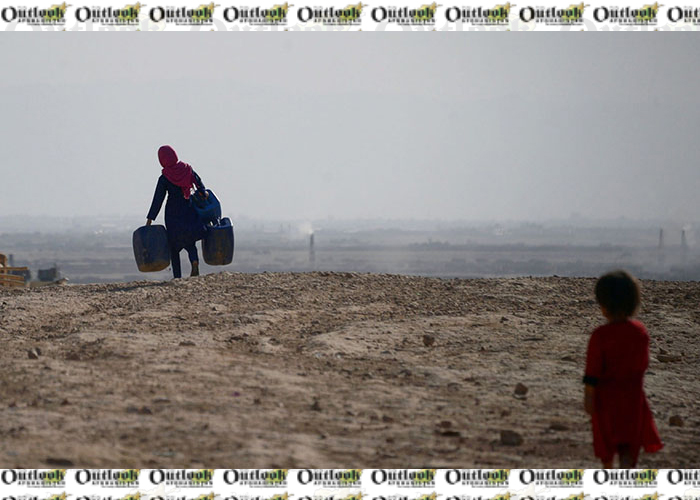Although the summer has just begun and today is the first day of this season in Afghanistan, the bell of drought crisis has already alarmed in the country. The Ministry of State for Disaster Management has announced the beginning of drought in 25 provinces of the country. The Ministry of Refugees and Repatriations of Afghanistan has informed of 18 thousand displacements as a result of the drought crisis. The Red Crescent officials have predicted that at least one-third of Afghan people will face food shortages in the country. Based on these alarms, the drought and water shortage are going to threaten the lives of millions of citizens and livestock in the country. However, the government has predicted about 17 million$ budget to combat the crisis, but the vastness of the nationwide crisis seems beyond the fiscal capacity of the government to overcome the issue. Therefore, Afghan people are going to face a hard summer while other challenges such as insecurity, third of wave of covid-19, and poverty have already challenged the normal lives of Afghan people.
As pointed, nearly all provinces are faced with drought and water shortage but some provinces include Herat, Badghis, Nimroz, Helmand Ghor, Jozjan, Bulkh, Sare-pool, Faryab, Badakhshan, Takhar, Bamyan, Daikundy, panshir, Kabul, Kapisa, Maidan wordak, Nangarhar, Qandhar, Ghazni, Paktiya and parwan are more at risk of drought this year. Out of these provinces, the large cities such as cities such as Kabul, Bulth, Qandahar and Herat are even faced with shortage of drinking water. It said that the ground water of Kabul crowded city has dropped to 40 meters because of drought, population growth, climate change, and the misuse of water resources. Besides the drought issues, there is also another factor that deprives the citizens of drinking water.Given the fact that the water supply needs electricity but the electricity pylons are frequently destroyed by terrorist groups and enemies of enlightenment. In fact, the destruction of power pylons has become a chronic problem in Afghanistan. Since 2018 and 2019 the enemies of enlightenment have been successively put pressure on the government and people interrupting the normal lives of people in most parts of the country. Generally, at least 25 power pylons have been destroyed in recent weeks and months while after each incident the electricity cut off from 11 provinces of the country imposing millions of expenses on Da Afghanistan Breshna Sherkat in repairing power pylon. Instead of implementing developmental projects, Da Afghanistan Breshna Sherkat is compelled to spend in repairing pylons as consequence.
The next factor behind drought and water shortage is global climate change. Almost all experts believe that Afghanistan has enormously impacted by global climate change and so the level of rainfall and snowfall has also reduced considerably. We will have an uncertain climate or rainfall status in the country and so we need to readiness against the uncertain conditions. Although the government has some preparation for the upcoming droughts, it might be beyond the financial ability of the government to deal with the issue. A few years ago when there was a drought in 22 provinces of the country, up to 150,000 heads of livestock had perished. In some provinces, some families had been forced to sell their household items to buy food. Therefore, it is more likely that the previous crisis may repeat in the emerging summer. The last factor that worsens the condition in Afghanistan is the traditional conditions of agriculture. Therefore, the agriculture system of Afghanistan is extremely vulnerable to drought and its implications. The farms and agricultural products are extremely dependent on rainfall. Based on recent official reports, 24% of wheat products are going to decline this year while millions of trees and livestock are extremely at risk of annihilation because of lack of rainfall. As soon as rainfall decreases, the farmers have no choice other than to minimize their losses by delaying planting crops and reducing field sizes. However, this is not a good strategy in general as the rain-fed agriculture system which mostly located in the mountains and hills is dependent to rain for irrigation. Therefore, if the rainfall decreased, the rain-fed agriculture system will again be reduced to zero and the farmer will suffer the most.
The good news is that during the presidency of Mohammad Ashraf Ghani dozens of water dams were built or under construction around the country. It is said that 14 water dam is under construction while 44 others are under plan to be built in the future. For example, the project Lalandar water dam Chahar Asyab district and Shah Wa-Aroz Dam in Shakardara district are close to Kabul city. These dams can water billions of people in Kabul city if the National Bureau of Water Administration can divert the water into Kabul city through pipelines. Thus, these water dams can benefit Kabul city through water injection into the ground of large cities, especially Kabul which extremely suffering from shortage of water.
On the whole, this summer will be a hard summer for Afghan people, especially for the farmers and citizens in large cities. The United Nations had already announced that the number of people in need of humanitarian assistance in Afghanistan will increase. The organization’s Office for Humanitarian Coordination had earlier announced that 18 million Afghans will need humanitarian assistance in 2021, which is 5 million more than previous years. Therefore, the government and international charities need to be prepared as millions of people to face famine and displacement in the upcoming weeks and months.
Home » Opinion » Public Fears and Concerns over Drought and Famine Crisis in Afghanistan
Public Fears and Concerns over Drought and Famine Crisis in Afghanistan
| Mohammad Zahir Akbari

